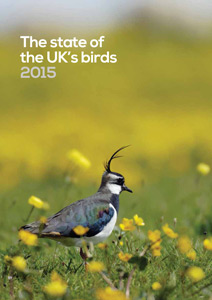The State of the UK's Birds 2015
Author(s): Hayhow D.B., Bond A.L., Eaton M.A., Grice P.V., Hall C., Hall J., Harris S.J., Hearn R.D., Holt C.A., Noble D.G., Stroud D.A. and Wotton S.
Published: April 2016
Publisher: RSPB, BTO, WWT, JNCC, NE, NIEA, NRW and SNH
Download article 3.34 MB application/pdf
Over the last four decades, declines in farmland birds have been shown to be due to a number of factors including the loss of mixed farming; increased use of pesticides; changes in grassland management and changes in crop type and the timing of management. The effects of predation and climate change, and threats to migratory species away from their breeding grounds are also playing a role.
Agri-environment schemes provide the primary mechanism for improving conditions for farmland birds so how these are delivered in the future is critical. Other future challenges for farmland birds include emerging diseases and the development and use of new pesticides such as neonicotinoids.
The importance of volunteer data
Volunteer data continue to provide most of the information used to update the trends reported for the UK, one of the two key examples being the more than 2500 volunteer participants in the Breeding Bird Survey. Providing annual population trends for more than 100 species, the BBS results highlight six species with severe declines just since 1995: Turtle Dove, Willow Tit, Wood Warbler, Grey Partridge, Pied Flycatcher and Whinchat. Four of these species are long-distance migrants and three are woodland specialists.
Counts by volunteers at more than 2,200 wetland sites at monthly intervals for the Wetland Bird Survey provide the information to report on wintering population trends in 46 species or races of waterbirds including ducks, geese, swans, waders, grebes, rails and cormorants. After two decades of increase, the wintering waterbird indicator has been declining over the last decade, particularly among species such as Turnstone and Purple Sandpiper, characteristic of the non-estuarine coasts.
"Without the dedication of thousands of volunteers, and partnerships between a whole suite of organisations, bird monitoring could not function on the scale illustrated by the latest the 'State of the UK's Birds'. From monitoring comes conservation action, and it is uplifting to read examples of partnership projects working to conserve the UK's birds. The latest SUKB celebrates both volunteer effort and innovative partnerships, something volunteers and partnership organisations should be proud of. Now to continue this great work..."
Sarah Harris, Breeding Bird Survey National Organiser.
Scarce and rare breeding species
SUKB 2015 once again includes a summary of trends in scarce and rare breeding species, drawn mainly from the annual reports of the Rare Breeding Bird Panel and the SCARABBS programme of periodic surveys. A number of these birds are perilously close to extinction in the UK: one species, the Wryneck, may be already, as the last known breeding record was in 2002 and the Golden Oriole has not bred since 2009.
Red-backed Shrikes appeared to be going the same way, but successful breeding in Devon and the Highlands in recent years gives us some cause for hope. While Red-backed Shrikes and Wrynecks were once found breeding across large parts of the UK, species such as Purple Sandpipers, Savi’s Warblers, Marsh Warblers, Redwings and Fieldfares have never, to the best of our knowledge, been anything more than rare breeders. The UK lies at the edge of their breeding ranges, and their fortunes here are dependent on how they fare elsewhere in Europe. Apart from input to international conservation policy, the best we can do is to protect the few pairs that do breed.









Share this page